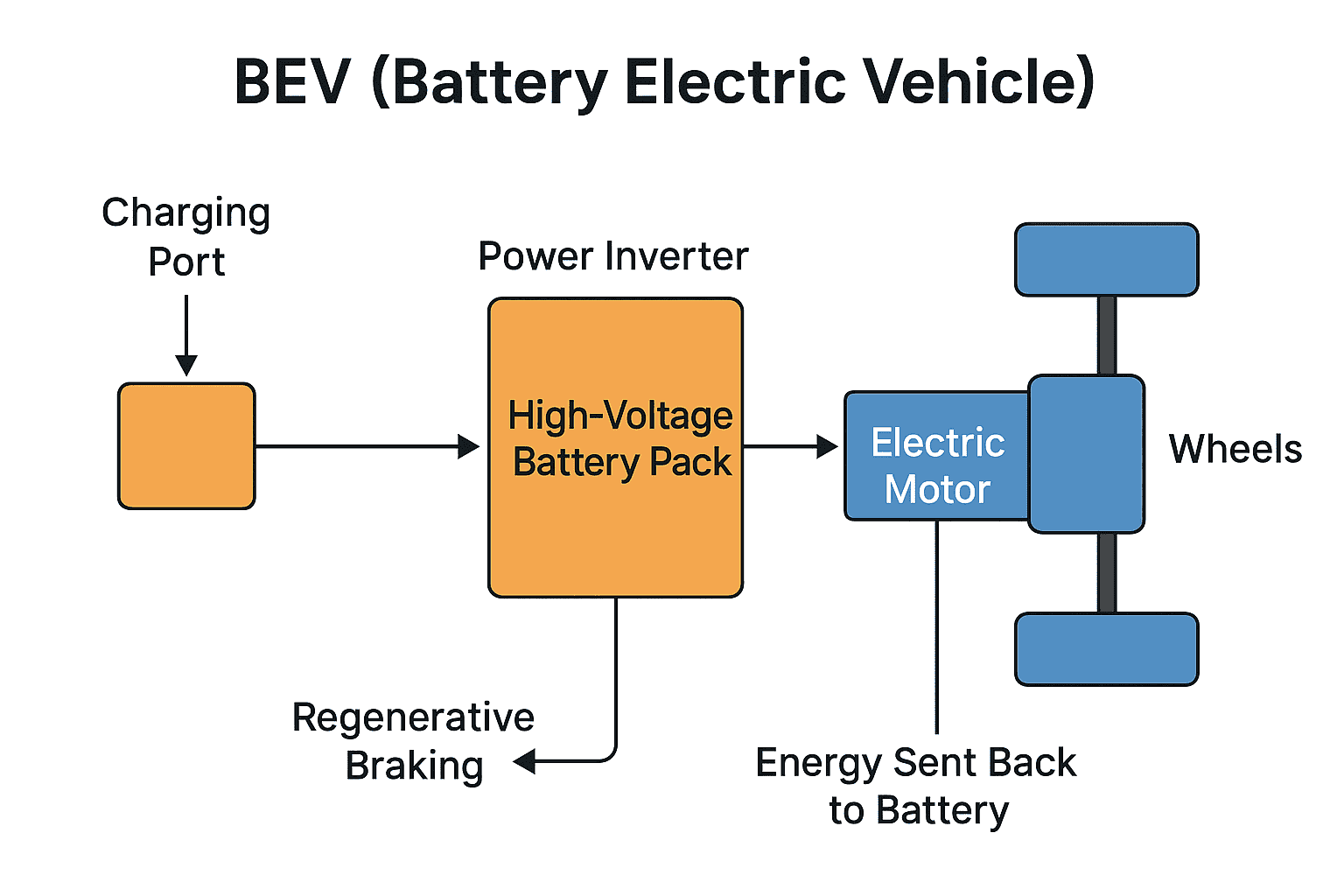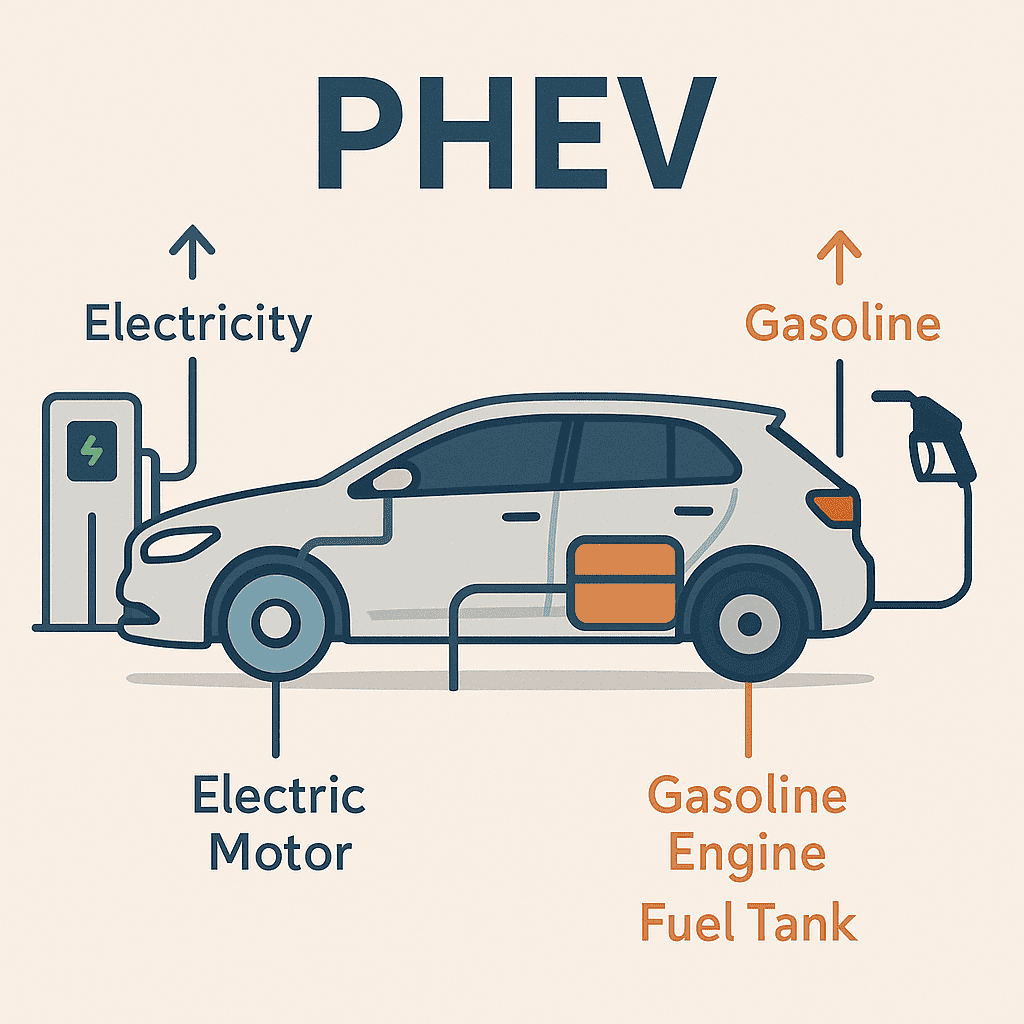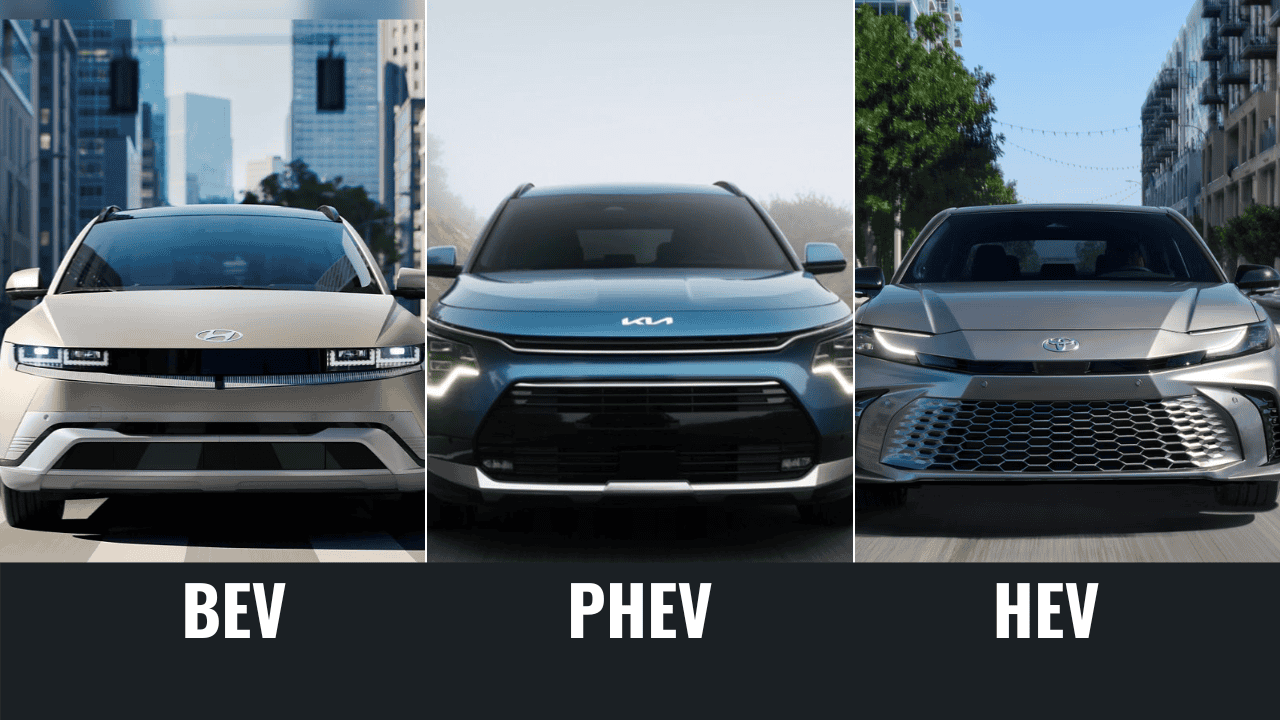Electric vehicles (EVs) are no longer a futuristic concept—they’re here, growing in popularity every day. As more people consider switching to cleaner transportation, one key question arises: BEV vs PHEV vs HEV—what’s the difference, and which one fits your lifestyle best?
If you’re overwhelmed by acronyms, don’t worry. This guide breaks down the distinctions between Battery Electric Vehicles (BEVs), Plug-in Hybrid Electric Vehicles (PHEVs), and Hybrid Electric Vehicles (HEVs), helping you make an informed choice.
What is a BEV (Battery Electric Vehicle)?
A BEV, or Battery Electric Vehicle, runs entirely on electricity. It has no gasoline engine and no tailpipe emissions. Power comes from a high-capacity battery, which you charge using a home charger or public charging station.

Pros of BEVs:
- Zero emissions: Completely clean—no pollution while driving.
- Lower running costs: Electricity is cheaper than gasoline, and fewer moving parts mean less maintenance.
- Smooth, quiet ride: Instant torque and no engine noise.
Cons of BEVs:
- Range anxiety: Limited range compared to gas cars (though improving rapidly).
- Charging time: Can take several hours to recharge, unless using a fast charger.
- Infrastructure dependence: You’ll need reliable access to chargers.
Popular BEVs include the Tesla Model Y, Hyundai Ioniq 5, and Nissan Leaf.
What is a PHEV (Plug-in Hybrid Electric Vehicle)?
A PHEV, or Plug-in Hybrid Electric Vehicle, uses both an electric motor and a gasoline engine. Unlike regular hybrids, PHEVs can be plugged in to recharge, offering an all-electric driving range for short trips, and switching to gasoline for longer journeys.

Pros of PHEVs:
- Best of both worlds: Use electricity for daily drives and gasoline for longer distances.
- Lower fuel costs: When charged regularly, PHEVs consume less fuel.
- Flexible and practical: Ideal for people with limited charging access.
Cons of PHEVs:
- Higher upfront cost: More complex technology makes them pricier.
- Limited electric range: Most PHEVs only offer 20–50 km of electric range.
- Still uses gasoline: Not completely emission-free.
Top PHEVs include the Toyota Prius Prime, Kia Niro PHEV, and Volvo XC60 Recharge.
What is an HEV (Hybrid Electric Vehicle)?
An HEV, or Hybrid Electric Vehicle, combines a gasoline engine with an electric motor, but cannot be plugged in. Instead, the battery is charged through regenerative braking and engine power. The system automatically switches between electric and gas modes for improved efficiency.
Pros of HEVs:
- Fuel-efficient: Great for city driving with lots of stop-and-go traffic.
- No charging needed: Convenient if you lack access to charging stations.
- Lower emissions: Cleaner than traditional gas cars.
Cons of HEVs:
- No electric-only mode: You’re always burning some gasoline.
- Less efficient on highways: Hybrid benefits drop at higher speeds.
- Limited EV feel: Doesn’t offer the smooth and silent EV driving experience.
Common HEVs include the Toyota Camry Hybrid, Honda Accord Hybrid, and Ford Escape Hybrid.
BEV vs PHEV vs HEV: Quick Comparison Table
| Feature | BEV | PHEV | HEV |
|---|---|---|---|
| Fuel Type | Electricity only | Electricity + Gasoline | Gasoline + Electric Assist |
| Charging Required | Yes | Yes | No |
| Emissions | Zero | Low (when using electricity) | Lower than gas cars |
| Electric Range | 150–500+ km | 20–50 km (varies) | Minimal |
| Cost to Run | Lowest | Moderate | Moderate |
| Ideal For | Daily commuters, eco-conscious drivers | Mixed driving needs | Urban drivers, no charging access |
Which One Should You Choose?
The BEV vs PHEV vs HEV debate ultimately comes down to your lifestyle and access to charging.
- Choose a BEV if you want zero emissions, low running costs, and have regular access to charging.
- Opt for a PHEV if you want flexibility, occasional long-distance capability, and plan to charge regularly.
- Go for an HEV if you don’t have charging infrastructure but still want better fuel efficiency and lower emissions.
As governments push toward electrification and offer incentives, now is a great time to explore these options. Whichever path you take in the BEV vs PHEV vs HEV comparison, you’ll be contributing to a cleaner, more sustainable future.
Final Thoughts
The shift to electrified transportation is accelerating. Understanding the nuances between BEV vs PHEV vs HEV is key to choosing the right vehicle for your needs. Whether you’re chasing zero emissions, fuel savings, or driving convenience, there’s an electric solution out there for you.
Also Read
- Tesla Model YL: New 6 Seater SUV Targets China’s EV Market
- 8 Tesla Model Y Alternatives in India You Can Consider in 2025
- 2025 Kia Carens Clavis EV Launch Tomorrow in India
- Tesla Enters India: First Showroom Launch & EV Delivery Plan
- Tesla Model Y Price Drops $20,000 in Canada, Imports from Germany
👉 Please 📩SUBSCRIBE to us for more real-world EV analysis, news, and deep dives — written for EV fans by EV fans.
Hey, I’m Badal! I’m super passionate about cars—especially electric ones. Whether it’s EVs, electric trucks, bikes, or anything with a battery and wheels, I’m all in. I love writing blogs and articles that break things down for fellow enthusiasts and curious readers alike. Hope you enjoy the ride as much as I do! Enjoyed reading? You can buy me a coffee on PayPal ☕ → paypal.me/BadalBanjare
